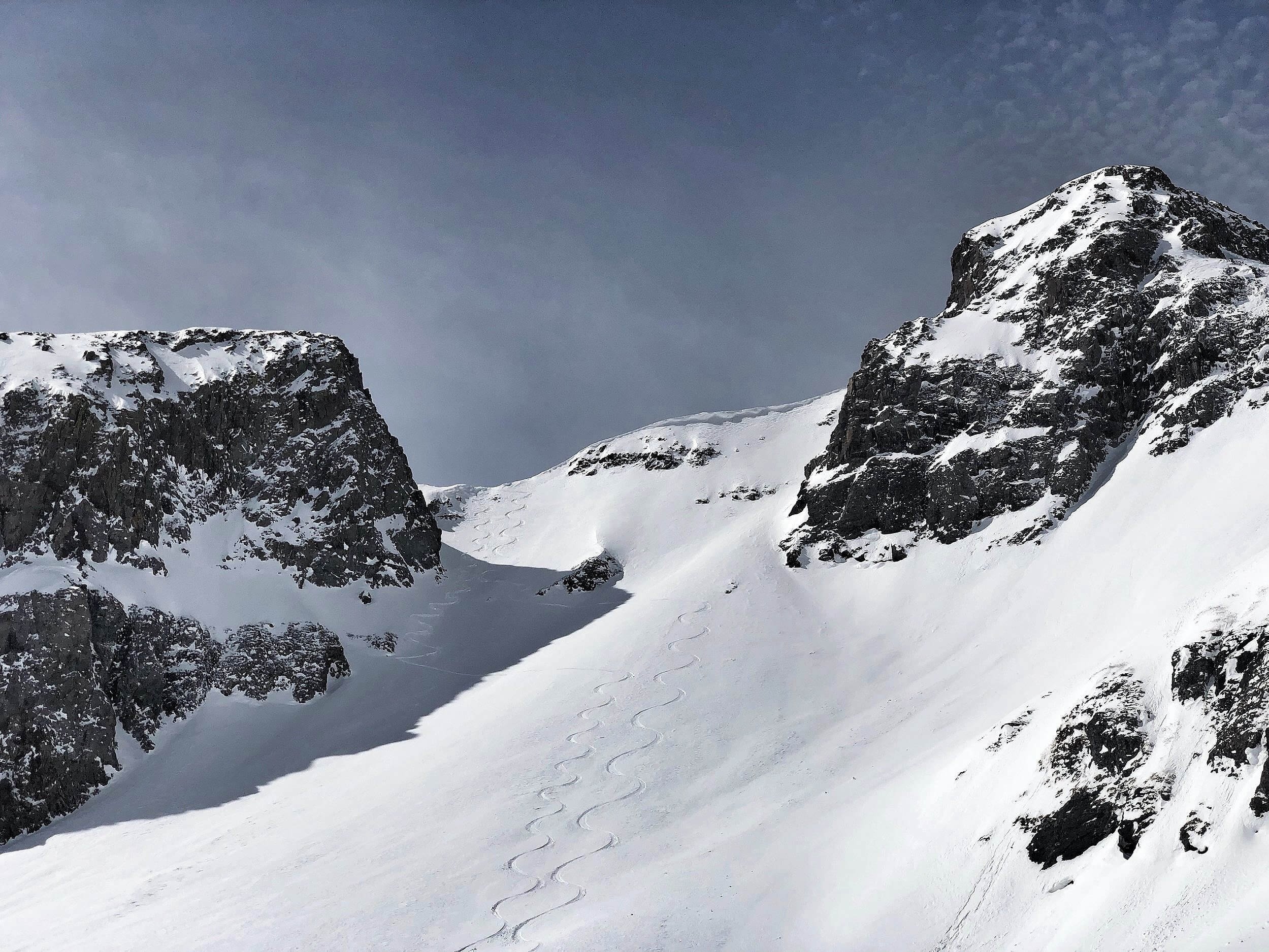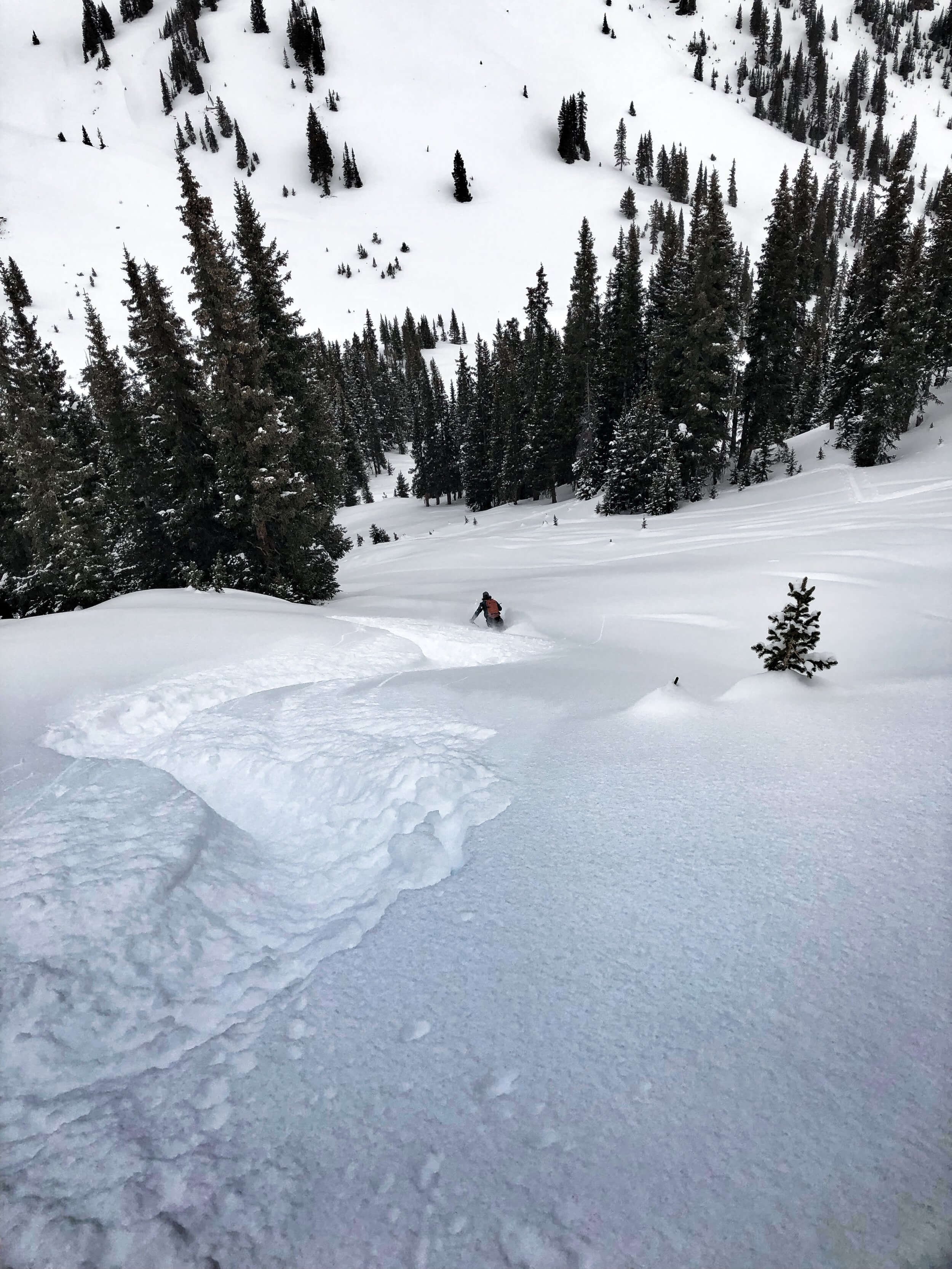
San Juan mountains, Colorado
Backcountry Skiing
Silverton Backcountry Skiing
Steep, exposed and epic - there is an abundance of extreme and exciting terrain in the Silverton area. A higher level of experience is recommended for much of the skiing here due to the advanced terrain. Couloirs, steep trees, chutes and peak descents await.
Classics in the area include skiing from the summit of Kendall Mountain 4,000’ rigght down into the town of Silverton, skinning up from the Silveton Ski area parking area to access the steep chutes and trees of upper Prospect Gulch, as well as peaks ans slopes around the popular ice climbing venue, Eureka. Come see why Silverton is a true, died-in-the-wool backcountry skiers paradise!
Red Mountain Pass Backcountry Skiing
Connecting the famous Colorado mining towns of Ouray and Silverton along Highway 550 lies Red Mountain Pass. Famous for its narrow, exposed roadway, it is equally well known among backcountry skiers for having some of the finest, easily accessible backcountry ski tours in all of Colorado, if not the country. Tours of all types and for all abilities can be found in any direction from the top of the 11,100’ pass: easy, safe low angle alpine powder runs, steep and wild couloirs and numerous 12-13,000’ ski accessible peaks. Red Mountain Pass is a great hub for skiers and boarders of all abilities. The area has great day tours and even plenty of lower hazard areas when the avalanche danger is concerning.
Lead guide, Vince Anderson, has been skiing and guiding tours on Red Mountain Pass for over 30 years! Vince also shares his ski passion as a Big Mountain & Freeride coach for a local kids ski team. He can also share his expertise with those just looking to up their ski skills as well as mentor folks on the process of becoming more self sufficient back country tourers. Let us share our love of this fantastic playground with you!
Contact us with your goals and interests and we are happy to help you set up a personalized itinerary.
Reliable ski touring in the San Juan mountains starts in December and can last through May. February and March often bring the largest snowfalls and early spring is a great time for steeper lines and ski mountaineering objectives.
For beginner-intermediate to advanced skiers/riders, no previous backcountry touring experience is required.
Montrose Regional Airport is 45 minutes from Ouray. There is NO rideshare service in town, you may book a shuttle service or rent a vehicle with AWD/4WD (for winter driving). If basing out of Silverton, it is possible to fly into Durango Regional Airport, 1 hour from Silverton.
There are plentiful hotels in downtown Ouray, though Silverton is another possible option. Hotels in either location are conveniently located walking distance to restaurants/breweries and the Ouray hot springs make a great aprés-ski relaxation.
Skiers/riders are responsible for providing their own personal clothing and touring equipment. Skyward Mountaineering may provide avalanche rescue equipment with advanced notice. See recommended equipment list below:
-
Long Underwear: Should be comfortable for a full day of activity, synthetic or merino wool will wick moisture away from the body
Ski socks: Over-the-calf winter weight for superior warmth. Heated socks (e.g. Lenz) are great!
Warm hat
Sun hat
Buff: Lightweight neck gaiter for adding warmth around ears or covering your face in windy or sunny conditions
Softshell gloves: Waterproof with high dexterity. 2 pairs recommended, one midweight and one heavyweight.
Mittens: mid-weight leather are great for colder conditions. Can be used with heat packs.
Midweight top baselayer: Merino wool or synthetic fibers will wick sweat away.
Heavyweight bottom baselayer: Optional for those that run cooler.
Midweight fleece jacket: An integrated hood adds warmth and weather protection
Active insulation jacket: Ideal balance of breathability and warmth for winter aerobic activity
Midweight vest: Optional, adds warmth to your core without restricting movement
Softshell jacket: Midweight with a helmet compatible hood. Should have Durable Water Resistance (DWR) coating
Ski pants: Can be hard or soft shell depending on the conditions (hardshell are best for colder, stormy or winter conditions). Side vents are nice to extend the comfort range for warmth on ascents. Must fit over boot cuffs.
Insulated parka: Only necessary for mid-winter and very cold days. Down is lighter/more compressible and a hydrophobic treated down will insulate even when wet. Should have at least 200 grams of 800 fill insulation
-
Skis with touring bindings: between 90mm and 115mm underfoot depending on snow type
Ski touring boots
Climbing skins fitted to skis; mohair or mohair mix is great, though full synthetic is fine.
Ski crampons compatible with bindings and skis
Adjustable poles (plus an extra basket)
Avalanche transceiver
Shovel
Avalanche probe
Ski helmet or climbing helmet
Day pack (30-40 liters) to carry extra clothes, helmet, water and food for the day (should have straps to carry skis)
-
Sunglasses: Dimmable recommended, CAT 3 lenses w/ athletic fit
Googles: Two pair recommended, one for low vis and another for sun/shade mix.
Small tube of sunscreen and SPF chap stick
First aid kit: Small, should include any personal medications and blister kit for feet.
Hand warmers: Optional, for those colder days
Fully charged phone
1-2 liters of water: A thermos with your favorite hot drink is recommended. Avoid water bladders and hoses as they are prone to puncture and freezing in a winter environment
High energy lunch and snacks: A healthy mix of fats, sugar, and protein for a full day of the on-the-go (leftover pizza or sandwiches are a great midday pick-me-up)
Sattelite communication: InReach, optional.
Small headlamp
Important: Let us know what you DO NOT have, we may have it.

Includes:
1 day of guided backcountry skiing/splitboarding with an AMGA Ski Guide
Does Not Include:
Additional expenses associated with a change in the itinerary
Transportation
Lodging
Meals
Guide gratuity



